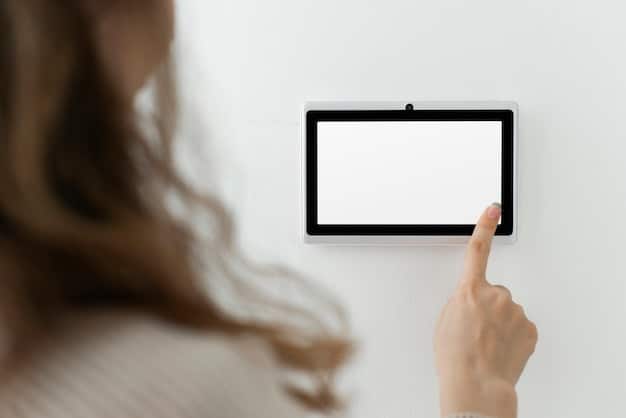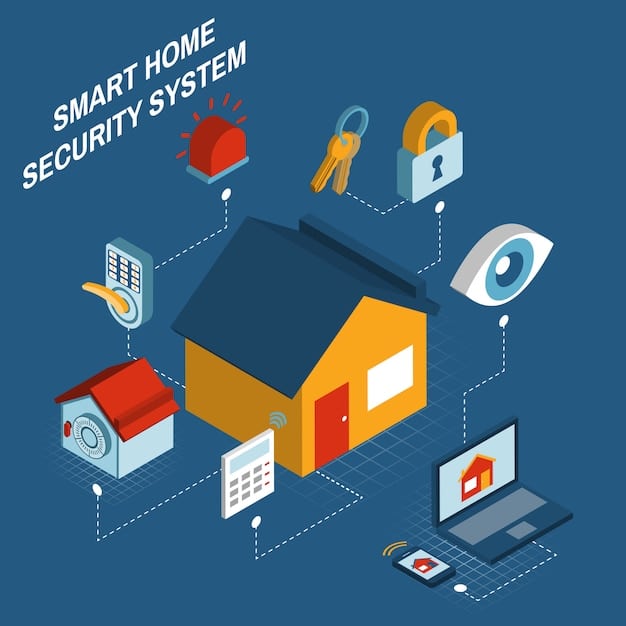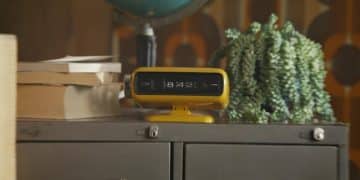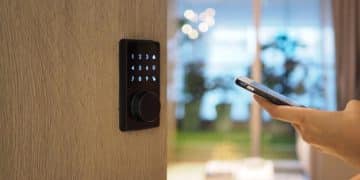Smart Home Maintenance: Essential Tips for a Smooth System

Smart home maintenance ensures your connected devices function optimally, enhancing security, conserving energy, and preventing costly repairs through regular check-ups, software updates, and hardware inspections.
The rise of smart homes has brought unparalleled convenience and connectivity. However, like any complex system, smart home maintenance is critical to ensure everything runs smoothly. Neglecting regular upkeep can lead to frustrating glitches, security vulnerabilities, and even costly repairs.
Smart Home Maintenance: Why It Matters
Maintaining your smart home isn’t just about keeping things working; it’s about maximizing your investment, ensuring your security, and enjoying the full potential of your connected devices. Skipping maintenance can lead to a host of problems, from minor inconveniences to serious security breaches.
Extending the Lifespan of Your Devices
Regular maintenance can significantly extend the lifespan of your smart home devices. Dust, temperature fluctuations, and power surges can all take a toll on sensitive electronics. By performing routine checks and cleaning, you can prevent premature failure and avoid costly replacements.
Enhancing Security and Privacy
A poorly maintained smart home can be a security nightmare. Outdated software, weak passwords, and unpatched vulnerabilities can all be exploited by hackers. Regular security audits and updates are essential to protect your personal data and prevent unauthorized access to your network.
Improving Energy Efficiency
Many smart home devices are designed to save energy. However, these savings can be negated if the devices aren’t properly maintained. For example, a smart thermostat that isn’t calibrated correctly may not accurately regulate the temperature, leading to wasted energy.
- Regularly update your smart home devices’ software.
- Check and adjust energy-saving settings.
- Clean sensors and ensure proper functionality.
By prioritizing maintenance, you can ensure your systems and devices operate efficiently, consistently delivering the benefits you expect.
Creating a Smart Home Maintenance Checklist
Developing a comprehensive maintenance checklist is the first step towards ensuring your smart home stays in top condition. This checklist should include regular tasks, seasonal checks, and troubleshooting steps to address common issues. Adapt the checklist to your specific devices and needs for optimal results.
Regular Tasks (Weekly/Monthly)
These are the tasks you should perform regularly to keep your smart home running smoothly. They include basic checks, updates, and cleaning to prevent minor issues from escalating.
Seasonal Tasks (Quarterly/Annually)
Seasonal maintenance tasks address issues that are specific to certain times of the year. These may include preparing your smart thermostat for winter, checking outdoor security cameras for weather damage, or ensuring your smart sprinkler system is ready for spring.
Troubleshooting (As Needed)
This category of tasks includes steps to take when something goes wrong. This could involve resetting a device, checking network connections, or contacting customer support. A well-defined troubleshooting process can help you quickly resolve issues and minimize downtime.

Software Updates: The Key to a Secure System
Software updates are a critical component of smart home maintenance. These updates often include security patches, bug fixes, and new features. Failing to install updates can leave your smart home vulnerable to cyberattacks and other issues.
Why Software Updates Matter
Software updates are essential for maintaining the security and functionality of your smart home devices. They address vulnerabilities that hackers can exploit to gain access to your network and personal data. Additionally, updates often include performance improvements and new features that can enhance your user experience.
How to Automate Software Updates
Many smart home devices offer the option to automate software updates. This can save you time and ensure your devices are always running the latest version of the software. Check the settings for each of your devices to see if automatic updates are available.
Manual Updates: When and How
In some cases, you may need to manually update your smart home devices’ software. This may be necessary if a device doesn’t support automatic updates or if you want to install an update immediately. Refer to the device’s manual or the manufacturer’s website for instructions on how to manually update the software.
- Set up automatic updates whenever possible.
- Regularly check for manual updates.
- Read release notes to understand what’s included in each update.
Implementing a proactive approach to software updates keeps your smart home secure, efficient, and up-to-date with the latest features.
Hardware Maintenance: Keeping Your Devices in Shape
Hardware maintenance is just as important as software updates. This includes cleaning your devices, checking for signs of wear and tear, and ensuring they are properly connected. Regular hardware maintenance can prevent malfunctions and extend the lifespan of your smart home devices.
Cleaning Your Devices
Dust and dirt can accumulate on your smart home devices, affecting their performance. Use a soft, dry cloth to clean your devices regularly. Avoid using harsh chemicals or abrasive cleaners, as these can damage the finish or internal components.
Checking Connections
Loose or damaged connections can cause your smart home devices to malfunction. Regularly check the power cords, network cables, and other connections to ensure they are securely plugged in. Replace any damaged cables or connectors immediately.
Identifying Wear and Tear
Over time, smart home devices can show signs of wear and tear. This may include cracked screens, frayed cables, or loose buttons. Address these issues promptly to prevent further damage and ensure the devices continue to function properly.
Hardware maintenance requires patience and attention to detail. Following a routine will make it easier to keep everything in top shape.
Network Security: Protecting Your Smart Home from Intruders
Securing your home network is paramount for protecting your smart home from cyber threats. A compromised network can expose your personal data, allow hackers to control your devices, and disrupt your internet service.
Strengthening Your Wi-Fi Password
Your Wi-Fi password is the first line of defense against unauthorized access to your network. Choose a strong password that is at least 12 characters long and includes a combination of uppercase and lowercase letters, numbers, and symbols. Avoid using easily guessable passwords, such as your name, birthday, or address.
Enabling Network Encryption
Network encryption scrambles the data transmitted over your Wi-Fi network, making it unreadable to unauthorized users. Use strong encryption like WPA3 where possible, or at minimum WPA2.
Using a Firewall
A firewall acts as a barrier between your network and the outside world, blocking unauthorized access and preventing malicious software from entering your system. Most routers have a built-in firewall, which should be enabled and properly configured.
- Perform regular password audits and updates.
- Keep firmware updated on your router.
- Use a complex, unique password for each account when possible.
Prioritizing network security isn’t just about protecting devices. Instead, it’s about safeguarding your digital lifestyle and giving you peace of mind in your connected home.

Smart Home Security: Surveillance and Intrusion Detection
Smart home security systems offer a range of features, including video surveillance, motion detection, and door/window sensors. Regular maintenance is essential to ensure these systems are functioning properly and providing adequate protection.
Checking Camera Placement and Functionality
Position your security cameras in strategic locations to provide comprehensive coverage of your property. Ensure the cameras are properly mounted and angled to capture clear footage. Regularly check the cameras’ functionality to ensure they are recording and transmitting data correctly.
Testing Motion Sensors and Alarms
Motion sensors and alarms are key components of your smart home security system. Test these devices regularly to ensure they are functioning properly. Check the batteries, sensitivity settings, and alarm volume to ensure they are providing adequate protection.
Reviewing Security Footage
Review your security footage regularly to identify any potential security threats or vulnerabilities. This can help you detect suspicious activity, identify areas where your security could be improved, and provide valuable evidence in the event of a crime.
Regularly review footage, test alarm sensitivity, and check battery life to proactively manage and protect your property, increasing your overall sense of safety and security.
Troubleshooting Common Smart Home Issues
Even with regular maintenance, you may encounter issues with your smart home devices. Knowing how to troubleshoot common problems can save you time and frustration. Here are some common issues and how to resolve them.
Device Not Responding
If a smart home device is not responding, start by checking the power and network connections, making sure the device is properly plugged in and connected to your Wi-Fi network. Then, try rebooting the device, resetting it to the factory settings if necessary. If the device still doesn’t respond, contact the manufacturer’s customer support for assistance.
Connectivity Problems
Connectivity problems can be caused by a variety of factors, including a weak Wi-Fi signal, interference from other devices, or router issues. Try moving the device closer to the router, reducing interference from other devices, or rebooting the router. If the problem persists, try updating the router’s firmware or contacting your internet service provider for assistance.
Software Glitches
Software glitches can cause your smart home devices to malfunction or behave unpredictably. Try updating the device’s software, clearing the cache, or resetting the device to the factory settings. If the problem persists, contact the manufacturer’s customer support for assistance.
| Key Aspect | Brief Description |
|---|---|
| 🛠️ Regular Updates | Keep software updated to patch security flaws. |
| 🛡️ Network Security | Secure your Wi-Fi with a strong password and encryption. |
| 🧹 Hardware Cleaning | Dust devices regularly to prevent overheating. |
| 🚨 Security Checks | Test alarms and review camera footage regularly. |
FAQ
▼
Ideally, update your devices as soon as updates are available. Setting up automatic updates is highly recommended for seamless and secure smart home management.
▼
Use a soft and dry microfiber cloth to gently clean the surfaces of your smart home devices. Avoid excessive pressure and never use liquid cleaners.
▼
Strengthen your Wi-Fi password and use WPA3 encryption. Also, update your router’s firmware. Enable firewalls for an extra layer of protection.
▼
Check the proximity to the router and verify your Wi-Fi credentials are correct. Reboot both the device and router. Ensure no other devices are causing interference.
▼
Start by restarting the system. Check the power and internet connections. Consult the system’s support page or contact customer service for specialized assistance.
Conclusion
Maintaining a smart home requires ongoing attention and care. By following these essential tips, you can ensure your smart home system runs smoothly, stays secure, and provides maximum convenience and enjoyment. Regular maintenance not only extends the lifespan of your devices but also enhances your overall living experience and makes life more efficient.





